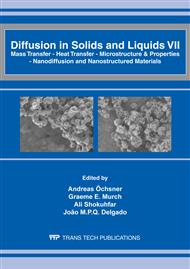p.465
p.471
p.477
p.482
p.488
p.494
p.498
p.504
p.509
An Attempt to Apply Darcy′s Flow Law in MMC Recycling Process Analysis
Abstract:
To determine the possibility of carrying out the recycling process of metal-matrix composite castings with saturated reinforcement, only Dupre equation was used until now. Basing on this equation, one can determine superficial conditions in the system: liquid metal (matrix) solid reinforcement medium, favouring the process of autogenous outflow of liquid matrix from the porous reinforcement. It is however very difficult to determine the influence of the structure parameters of reinforcement preforms on examined process. Hence the need to preform analysis of process of liquid metal matrix outflow using Darcys law of flow. Application of this law allows replacing difficult to determine parameters of capillaries occurring in performs with one, quite simple to calculate parameter of permeability. It also makes possible defining the influence of temperature and time of recycling process on yield of matrix metal. To verify stated theses, study of permeability of selected reinforcement preforms and recycling of selected metal-matrix composites with saturated reinforcement was conducted. Furthermore, analysis of liquid metal matrix outflow process from studied preforms was performed, in aspect of application of Darcys law.
Info:
Periodical:
Pages:
488-493
Citation:
Online since:
April 2012
Authors:
Price:
Сopyright:
© 2012 Trans Tech Publications Ltd. All Rights Reserved
Share:
Citation:


